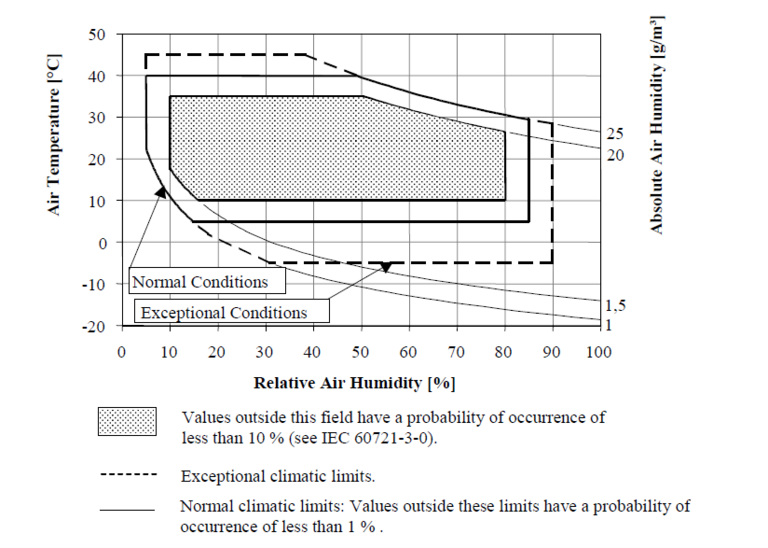The development of Free Cooling in Telecom and Infra: a sustainable continuation.

Free Cooling in Telecom and Infrastructure
The continued rollout of fiber, Edge computing and 5G are causing shockwaves in digital infrastructure. In addition to traditional data centers, smaller, more compact facilities are being added en masse to locally process the newly created data traffic. These new situations call for different solutions than are usual in data centers. In addition, customized developments and standards play a major role. In response, new solutions are needed that use free air cooling. How should we deal with these new standards and what should we take into account?
In this blog article we explain what to take into account, based on the ETSI standards and various noise requirements that have recently changed.
Ambient conditions & temperature control should comply with ETSI EN 300 019-1-3 V2.3.2.
More and more often you see in the demand specifications for Telecom and Infrastructure projects that for the cooling parameters reference is made to the ETSI EN 300 019 standard concerning ambient conditions and temperature control. In addition, there are additional requirements for the noise level, which then refers to the government by 1-4-2021 updated building code of 2012 (Bulletin of Acts and Decrees 2020, no. 189).
For applications that fall under this you can think about:
- Telecom POP stations and Streetcabinets
- 5G setup DU's, CU's and core
- Modular prefab data centers
- Land Stations at Wind Farms
- Traffic systems
- High-voltage substations at electricity networks
- Sub stations and switching stations at railroad applications
- ERTMS, signalling and signalling equipment installed directly alongside the tracks
What is the ETSI EN 300 019-1-3 V2.3.2?
Literally, the ETSI standardization implies the following:
Environmental conditions and environmental tests for telecommunications equipment; Part 1-3: Classification of environmental conditions; Stationary use at weather protected locations.
Freely translated it is about the different environmental conditions of the equipment and what they should meet. If you consult the ETSI standard you will find under section 4.1 "Temperature controlled locations" the following climatogram with which you must comply. This climatogram is the guideline for the ETSI standard.

The capacity to be cooled depends on the application and the equipment installed. The basic temperature is usually between 10 and 35 degrees Celsius. The upper limit is 10% of the year between 35 and 40 degrees, which comes down to about 876 hours. And 1% of the year between 40 and up to 45 degrees which amounts to approximately 87 hours. The lower limit is 10% of the year between 5 and 10 degrees which equates to approximately 876 hours. And 1% of the year between -5 and up to 5 degrees which amounts to approximately 87 hours.
With these specific values, it is possible to select the required products, including free cooling, on the basis of various specifications. This is possible with a configuration program.
Noise requirements in accordance with updated building code.
Now that the legislation has been tightened up since April this year with regard to cooling units/heat pumps installed outside, the maximum requirement is 40 dB(A) at the property boundary (!) with a real chance that this will need to be further tightened up by 5 dB(A) from the operators due to the tonal nature of the fans. In fact, it has become almost impossible to achieve this with standard outdoor units.
The noise level must comply with national and local (legal) requirements.
The location should be chosen so that any nuisance noise is minimal. This should also be carefully coordinated with the municipality and put in writing as early as the pre-engineering phase. One should be aware of and adhere to the regulations and requirements applicable in the country.
Nr.Description AreaTreshold Laeq in dB(A)
| Day | Evening | Night | ||
| 1 | Quiet rural areas Areas for extensive recreation | 40 | 35 | 30 |
| 2 | Rural area with many agricultural activities | 45 | 45 | 35 |
| 3 | Quiet residential area, little traffic | 45 | 40 | 35 |
| 4 | Quiet residential area in town | 50 | 45 | 40 |
| 5 | Mixed residential area, combinations of residential and light business activities | 55 | 45 | 40 |
| 6 | Residential area near a busy traffic road (car and rail) | 55 | 50 | 45 |
| 7 | Residential area near zoned industrial area | 55 | 50 | 45 |
| 8 | Residential area in city center | 55 | 55 | 45 |
| 9 | In zone around industrial area | see Wgh: zone, MTGs*, higher values | ||
| 10 | On industrial estate (see section 5.9) | <=65 | <=60 | <=55 |
* MTGs highest allowable value of the noise load, as a result of the inudstry terrain, near the facades of dwellings; section 72 Wgh
A third additional requirement is that solutions should usually be as energy efficient, sustainable and cost effective as possible. Energy waste should, in accordance with European legislation, be avoided where possible, also called Green Grid. (Green Grid is an initiative to make industries as energy efficient as possible). In practice, this means that we prefer to work only with free cooling in order to save on the energy consumption of forced cooling.
How to respond to the new developments?
These three previous requirements from the demand specifications made STULZ decide that the current Telecom line should be further expanded to include 100% Free Cooling systems, possibly with associated air diffusers and integrated coulisse silencers so that your project complies with all applicable regulations at all times.
It is becoming increasingly important to look at the overall picture of each project. Our advice is no longer limited to the airconditioning unit required, but looks at the total project solution. STULZ is increasingly acting as a knowledge partner, because contractors do not always have this specific expertise in-house. Together with our partners, we look at the cohesion within a project, for example, the required cooling capacity and airflow/volumes in the room and to the outside, the noise level of the unit, the arrangement in the room, whether a computer floor is used, the location outside, the environmental conditions that must be met and how it is all integrated with the systems for the end users.
STULZ telecom cooling systems are immediately ready for connection and operation according to the plug-and-play principle. They can be configured exactly according to customer-specific needs and requirements and ensure that the system remains available 24 hours a day, 7 days a week for years to come. For more information, keep a close eye on our website and social media channels to stay informed about new developments.
